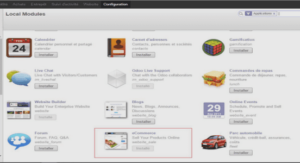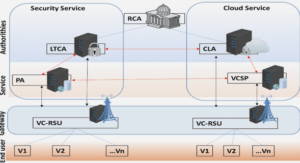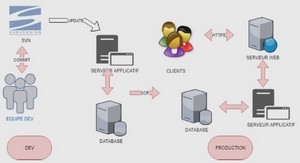The 5G technology coming in the near future refers to the fifth generation of mobile communication networks. It is being standardized by the 5G-PPP Architecture Working Group (until 2020) to be able to satisfy the ever-increasing traffic demand and to serve more users with stringent service requirements (like higher data rates, ultra-low network latencies and low energy consumption). Mobile broadband services, Machine-to-Machine (M2M) communications, and ultra-low latency applications are the main types of service scenarios offered by 5G technology. The cellular network architecture of future 5G network is based on random and ultra dense small cells for more flexibility and scalability. The 5G technology is bringing several new concepts such as: Software-Defined Network (SDN), Network Function Virtualization (NFV), millimeter wave spectrum, massive Multi-Input Multi Output (MIMO), network ultra-densification, big data and mobile cloud computing, Internet of Things (IoT), Deviceto-Device (D2D) connectivity, green communications, and centralized Radio Access Network (C-RAN). Some of these technologies have been studied in current LTE-Advanced networks. Nevertheless, the exponential growth in traffic demand and data rates in 5G is driving to new scalability and financial challenges that need to be further addressed (I. F. Akyildiz, S. Nie, S-C. Lin, M. Chandrasekaran, 2016)
5G service requirements
Few years ago, end-user traffic was generated basically by mobile phones which required relatively low data rates and simple service requirements. Today, several types of connected devices and end-user applications such as smart watches, autonomous vehicles, Internet of Things (IoT), Augmented Reality (AR) and tactile Internet are driving to new network and user experience requirements. Coming 5G technology is bringing even more scalability and performance challenges due to the expected explosion in traffic demand and number of connected devices. The various service requirements of future 5G technology are summarized as follows:
– High connectivity: future cellular architecture is driven by a very high-density Heterogenous Networks (HetNets) with several small cells inside macro cells to accomodate the cell edge end-users.
– Traffic demand and High data rates: Tremendous avalanche of traffic volume (10000 x more) with 10+ Gbps peak data rates and 100 Mbps cell edge data rates, etc.that will be addressed in 5G networks by new eMBB (enhanced Mobile Broadband) which provides greater data-bandwidth.
– High scalability: due to massive growth in connected devices (50 billion devices, i.e. 10 to 100 x more devices). This will be addressed in 5G networks by new mMTC (massive Machine Type Communications) which includes NB-IoT (Narrow-band Internet of Things).
– Reduced latency: due to new services requirements and characteristics such as Ultra-Low Latency (ULL) applications with latency ≤ 1 ms. This will be addressed in 5G networks by new URLLC (Ultra Reliable Low Latency Communications) wich will offer full end-toend latency reduction .
– Low energy: 1000 times less energy consumption per bit.
– Ultra low cost !!!
To address these huge throughput demand and ultra-low latency requirements, it is inevitable to redesign the entire network architecture by conidering an end-to-end network integration based on scalable, high bandwidth and Ultra-Low latency (ULL) technologies. A recent solution to drop the end-to-end network latency is based on the emerging network edging concept by building several new edge data centers to be as close as possible to the end-users of new 5G applications. This emerging edging approach where most of the network intelligence is moving to the edge / access layer will offer last-mile traffic a higher scalability and much lower propagation delays. The latency calculation will be basically depending on the communication delays introduced by the backhaul network since most of traffic does not to go anymore up to the core datacenters (in the core network). This validate once more the importance of the backhaul network to offer future 5G technology the required scalability, throughput and low latency .
Heterogeneous Networks (HetNets)
Heterogeneous Networks (HetNets) are defined by the cellular networks in the Radio Access Network (RAN) that collect the wireless traffic from the mobile end-users and forward it to the core network. HetNets are based on low-power small cells (like micro-cells, femtocells, picocells, and relay nodes) within bigger macro-cells in order to improve the coverage and required capacity. Small cells extend the coverage to the end-users, offload data traffic from congested macro-cells and uniformly distribute the available capacity of the network. The HetNets are connected to the core network thanks to the Mobile Backhaul (MBH) network , (A. BenMimoune, F. A. Khasawneh & M. Kadoch, 2015) .
Mobile Backhaul (MBH)
The Mobile Backhaul (MBH) is the access transport network that collects the traffic from several hundreds of high density radio access network (RAN) with hundereds of 3G and 4G mobile towers (respectively, NodeB and eNodeB). MBH then forwards the collected traffic towards centralized BBU (Base Band Unit) pools in the MNO core network, the MBH has to offer huge end-to-end scalability and reliability to address all end-user service requirements. Different wireless and wireline transport technologies are competing in the MBH such as SONET/SDH, ATM, OTN, GPON, Carrier Grade Ethernet, MPLS-TP, IP/MPLS, etc. (L. Li & S. Shen, 2011) .
INTRODUCTION |





